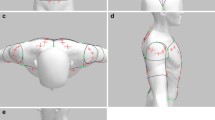Abstract
Fine analysis of body movements is now technologically feasible, together with simultaneous recording of multiple muscle activity. This is especially true for the trunk and back muscles during human walking. However, there have been few anatomic studies of the area where deep back muscle activity is recordable by skin electrodes. We therefore attempted to optimize skin electrode location for recording erector spinae muscle activity at different levels of the back. For this purpose, 20 dissections of the posterior wall of the trunk were performed. The cutaneous plane was reclined on both sides to expose the superficial muscles of the posterior wall of the trunk. We dissected then plane-by-plane until we exposed the erector spinae muscles. The widths of the fascial spinal muscle insertions were measured at spinal levels easily identified clinically, i.e., C7, T3, T7, T12 and L4. Electromyographic assessment of the electrode location at these levels was performed in three subjects. Erector spinae muscle activity proved possible to record on several areas of the posterior wall through a superficial muscle aponeurosis. We propose a protocol for placing skin electrodes to record erector spinae muscle activity based on clinical anatomical references.






Similar content being viewed by others
References
Anders C, Wagner H, Puta C, Grassme R, Petrovitch A, Scholle HC (2007) Trunk muscle activation patterns during walking at different speeds. J Electromyogr Kinesiol 17:245–252
Bogduk N (2005) Les muscles lombaux et leurs fascias. In: Anatomie du rachis lombal et sacré. Elsevier, Amsterdam, pp 131–167
Bouchet A, Cuilleret J (1983) Anatomie topographique, descriptive et fonctionnelle. Tome 2: Le cou et le thorax. Simep, Paris, pp 931–943
Callaghan JP, Patla AE, McGill SM (1999) Low back three-dimensional joint forces, kinematics, and kinetics during walking. Clin Biomech (Bristol, Avon) 14:203–216
Cappellini G, Ivanenko YP, Poppele RE, Lacquaniti F (2006) Motor patterns in human walking and running. J Neurophysiol 95:3426–3437
Carlson H, Nilsson J, Thorstensson A, Zomlefer MR (1981) Motor responses in the human trunk due to load perturbations. Acta Physiol Scand 111:221–223
Chen WJ, Chiou WK, Lee YH, Lee MY, Chen ML (1998) Myo-electric behavior of the trunk muscles during static load holding in healthy subjects and low back pain patients. Clin Biomech (Bristol, Avon) 13:S9–S15
Chevallier J (1998) Anatomie 2: Appareil locomoteur. Medecine sciences flammarion, Paris
Danneels LA, Coorevits PL, Cools AM, Vanderstraeten GG, Cambier DC, Witvrouw EE, De CH (2002) Differences in electromyographic activity in the multifidus muscle and the iliocostalis lumborum between healthy subjects and patients with sub-acute and chronic low back pain. Eur Spine J 11:13–19
Donisch EW, Basmajian JV (1972) Electromyography of deep back muscles in man. Am J Anat 133:25–36
Drake R, Vogl W, Mitchell A (2006) Musculature du dos. In: Gray’s anatomie pour les étudiants. Ed française, Elsevier Masson SAS, pp 45–65
Granata KP, Wilson SE (2001) Trunk posture and spinal stability. Clin Biomech (Bristol, Avon) 16:650–659
Hodges PW (2001) Changes in motor planning of feedforward postural responses of the trunk muscles in low back pain. Exp Brain Res 141:261–266
Ivanenko YP, Poppele RE, Lacquaniti F (2004) Five basic muscle activation patterns account for muscle activity during human locomotion. J Physiol 556:267–282
Ivanenko YP, Poppele RE, Lacquaniti F (2006) Spinal cord maps of spatiotemporal alpha-motoneuron activation in humans walking at different speeds. J Neurophysiol 95:602–618
Kamina P, Rideau Y (2000) Myologie des membres. Maloine, Paris, pp 14–15
Konz RJ, Fatone S, Stine RL, Ganju A, Gard SA, Ondra SL (2006) A kinematic model to assess spinal motion during walking. Spine 31:E898–E906
Kumar S, Zedka M, Narayan Y (1999) EMG power spectra of trunk muscles during graded maximal voluntary isometric contraction in flexion-rotation and extension-rotation. Eur J Appl Physiol Occup Physiol 80:527–541
Lamoth CJ, Meijer OG, Daffertshofer A, Wuisman PI, Beek PJ (2006) Effects of chronic low back pain on trunk coordination and back muscle activity during walking: changes in motor control. Eur Spine J 15:23–40
Lariviere C, Gagnon D, Loisel P (2000) The comparison of trunk muscles EMG activation between subjects with and without chronic low back pain during flexion-extension and lateral bending tasks. J Electromyogr Kinesiol 10:79–91
MacDonald DA, Moseley GL, Hodges PW (2006) The lumbar multifidus: does the evidence support clinical beliefs? Man Ther 11:254–263
Ng JK, Parnianpour M, Richardson CA, Kippers V (2001) Functional roles of abdominal and back muscles during isometric axial rotation of the trunk. J Orthop Res 19:463–471
Radebold A, Cholewicki J, Panjabi MM, Patel TC (2000) Muscle response pattern to sudden trunk loading in healthy individuals and in patients with chronic low back pain. Spine 25:947–954
Rohen J, Yokochi C, Lütjen-Drecoll E (1999) Anatomie Humaine: Atlas photographique d’anatomie systématique et topographique. Maloine, Paris, pp 209–215
Solomonow M, Zhou BH, Baratta RV, Burger E (2003) Biomechanics and electromyography of a cumulative lumbar disorder: response to static flexion. Clin Biomech (Bristol, Avon) 18:890–898
Sutherland DH (2001) The evolution of clinical gait analysis part l: kinesiological EMG. Gait Posture 14:61–70
Vialle R, Wicart P, Drain O, Dubousset J, Court C (2006) The wiltse paraspinal approach to the lumbar spine revisited: an anatomic study. Clin Orthop Relat Res 445:175–180
Wolf SL, Bobinac-Georgievski A, Braus V, Montani M (1997) Electrokinesiologic measurement of trunk sagittal mobility and lumbar erector spinae muscle activity. J Rehabil Res Dev 34:470–478
Author information
Authors and Affiliations
Corresponding author
Rights and permissions
About this article
Cite this article
de Sèze, M.P., Cazalets, JR. Anatomical optimization of skin electrode placement to record electromyographic activity of erector spinae muscles. Surg Radiol Anat 30, 137–143 (2008). https://doi.org/10.1007/s00276-007-0289-y
Received:
Accepted:
Published:
Issue Date:
DOI: https://doi.org/10.1007/s00276-007-0289-y




